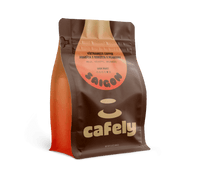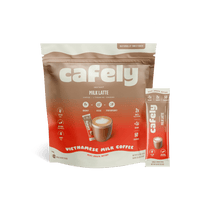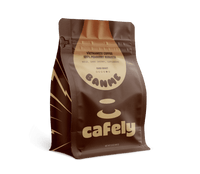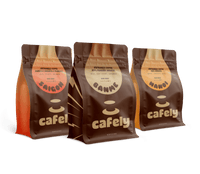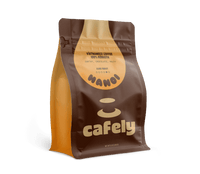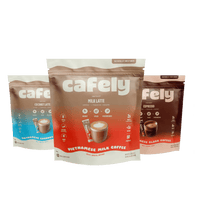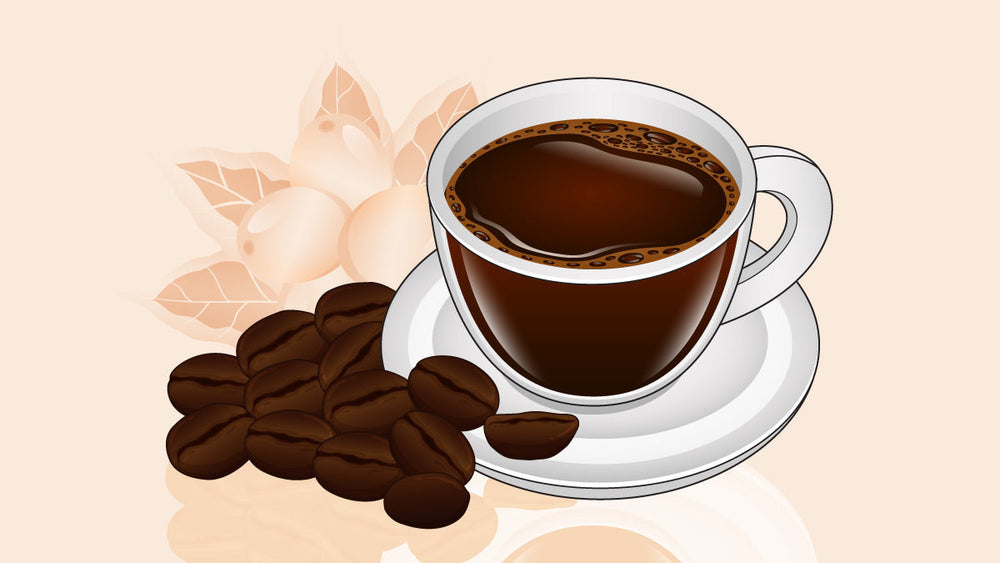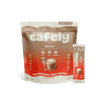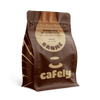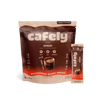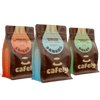Dark roast coffee is known for bold, intense, and bitter flavors, which leads to the incorrect assumption that you're brewing it wrong. But once you understand what's going on with these caramelized sugars and deep, smoky flavors, the dark roast world feels less intimidating.
Below, we break down what makes a dark roast and how to get the best of this bean in your home brewing.
What Is Dark Roast Coffee?
Dark roast coffee can be defined in a few ways. At a basic level, these are coffee beans roasted to a higher temperature or longer time than other coffees.
During roasting, coffee beans go from a green color when first harvested to the dark brown color we recognize. They change slowly, becoming golden, then golden-brown, and darkening the longer they bake.
A dark roast, therefore, is any coffee that is darker in color than other coffees. Generally, these are beans roasted to around 440˚F. However, there are many scales and measurements to define the border between a medium and dark roast, so the line is a little blurry.
Flavor Profiles: Dark Roast vs. Lighter Roasts
Roasting transforms green coffee into the rich, aromatic brew we love.
Two key reactions shape the flavor: steam pressure causes the beans to crack and release volatile compounds, while the Maillard reaction caramelizes sugars, creating deeper, toastier notes.
Dark Roasts
Long roast times burn off most of the bean’s original flavors, replacing them with bold, earthy, and bittersweet notes — think dark chocolate, berry, black cherry, caramel, and even a touch of smoke. The texture is smooth and the flavor, intense.
Lighter Roasts
Roasted for less time, these retain more of the bean’s original, plant-based flavors and chlorogenic acids. Expect brighter, more acidic notes like citrus, floral, fruit, and nut.
Medium Roasts
A popular middle ground — balanced acidity, rounded sweetness, and a good mix of origin character and roast flavor.
At this level of cooking, the coffee develops some distinct and delicious flavors.
Picking the Best Dark Roast Coffee

When looking at different dark roasts, how do you know which one is the best to choose? We’ll take you through some factors to consider.
Freshly Ground & Roasted
The most important thing to consider when buying coffee is freshness. The flavor and aroma of any coffee beans are volatile, which means they can be lost over time. Coffee loses its freshness in several ways, most notably through exposure to air, water, or sunlight. The best way to get great coffee is to purchase it immediately after roasting or grinding. Fresh coffee always tastes more complex and rich!
When buying coffee, take a look at the roasting date. Ideally, it should be as recent as possible. Anything under two weeks should still offer good flavor — as long as it's stored properly.
Grinding the coffee beans speeds up the process of losing flavor and aroma since there’s more surface area exposed to the air.
Ground coffee has the same storage requirements as whole beans — in an opaque, airtight container stored in a cool location. Depending on the quality of the container and the storage location, ground coffee should stay pleasantly fresh for one to two weeks.
Suggested: Roasting Coffee Beans at Home — A Definitive Guide
Arabica vs. Robusta
It’s also important to consider whether you’ll go for arabica or robusta. These species have a couple of flavor differences.
For example, arabica beans have more fat and sugar than robusta beans, so they can have a smoother flavor and work well as lighter roasts.
Robusta beans have less sugar, so they’re best developed in a dark roast, leading to an earthy, potent cup.
There are delicious dark roast blends that combine arabica and robusta beans, but the flavor complexity in a dark roast robusta is hard to ignore. On top of this, robusta beans have around double the caffeine as arabica beans, so your flavorful coffee can truly pack a punch.
Place of Origin
The coffee bean's origin can greatly impact how it tastes and smells. The coffee plant grows in different ways worldwide, drawing different flavors into the beans from the earth.
You see this on a small scale in Vietnam, where arabica beans are grown in the highlands, and robusta beans are grown at lower elevations.
The low-elevation robusta beans tend to be much less acidic than arabica. They have a rounded earthiness, which is usually enhanced by the longer roasting time.
This brings out the bean's sugars, often giving it a bittersweet note compared to dark chocolate or black cherry.
Highland arabica beans can have a higher acidity but they also have a higher sugar and fat content. These compounds mean their flavors can be smoother and more complex, and they're often roasted to a light or medium level to preserve this.
Butter Roasted
Vietnamese coffee roasters have made butter-roasted coffee for many years.
They initially did this to mask bad flavors in poor crops, but as agricultural knowledge has evolved, the crops have improved. It's no longer necessary to cover up flavors, but it still improves the complexity.
If you're looking for authentic Vietnamese coffee, you can't go wrong with a rich, potent butter-roasted coffee.
Coffee Bean Quality
Securing quality beans for your brewing at home will enhance your coffee experience to no end.
Here are some great things to look for:
- No Added Sugar — Roasters sometimes add sugar to their beans to mask bad flavors. By selecting coffee with no added sugar, you’re more likely to get great natural flavor.
- Freshness — Fresh beans have the most flavor but grow stale with time. Always check that the beans have been roasted in the last two weeks.
- Organic — Organic coffee means the plants were grown without human-made chemicals. This gives the plants more time to grow, which, in turn, allows them to develop better flavors. Plus, it helps you get chemical-free products.
- Mold-Free — Some crops can develop mold growth when shipped and stored. Look for certified mold-free beans to avoid mold and mycotoxins in your coffee.
Best Ways to Brew Dark Roast Coffee at Home
When brewing coffee at home, you'll want to start with the proper grinding.
Grinding coffee beans as soon as possible before brewing will produce more flavor in the final cup, but doing so too soon can lead to flavor loss.
The exact coarseness of your brewing will depend on the method you’re using.
1. Phin Filter

One of our favorite ways to brew dark roast coffee is with a phin drip filter — a traditional Vietnamese brewer that creates strong, flavorful cups.
For a phin, grind coffee to a fine consistency, similar to sand. The brewing method takes longer than others and uses an extremely fine mesh filter to separate the grounds and water. This, combined with the fine grind size, gives you a cup with a strong flavor and high caffeine content.
This brewing method is ideal for dark roast coffee because of the high extraction level. Like espresso, a phin brewer exposes the water and grounds to pressure thanks to the gravity press. This increases the flavor you can extract from the coffee, leading to a powerful cup.
2. Espresso

Dark roast and espresso coffee go hand in hand — the combination of short contact time and exceptionally high pressure means that lots of flavor can get into your cup in no time at all.
By tamping the finely ground coffee in the portafilter, you create a bed of coffee that increases resistance to the flow of water.
When you balance these factors, you should reach the optimum pressure of around nine bars.
The high extraction over the short contact time ensures that the earthy, sweet flavors developed during roasting are the first to be extracted. In turn, the resulting coffee is a showcase of the best that dark roast coffee has to offer.
3. Moka Pot

The moka pot works similarly to an espresso machine, but through the power of steam instead of an electric pump. As with espresso, add finely ground coffee to the filter and press it flat. Then, assemble the brewer and put the pot over a heat source.
As the water heats, it is forced through the coffee bed, and the final brew collects in the top chamber.
The benefit of the moka pot is the same as the drawback: the heat of the brewing water. Because the water is only forced through the bed when it's close to boiling, it can be too hot, leading to over-extraction.
However, removing the pot from the heat when large bubbles first appear allows you to stop the brewing a little early and be left with appropriately extracted coffee.
As with espresso, this brewing style's combination of high pressure and low contact time ensures that the final cup showcases the bittersweet flavors in dark roast coffee.
4. Cold Brew

Cold brew coffee is the exact opposite of the other methods discussed here: coffee is ground coarsely and combined with a large volume of water before being sealed in a container overnight.
This may seem counterintuitive, but the brewing method produces very smooth, rich, and sweet notes in the final cup.
Without getting too technical, the different flavors in coffee need different amounts of energy to be extracted. The sweet, rich flavors don't need much energy, but the sharp, astringent notes need more energy.
By using cold water, you're not putting extra energy into the coffee and only the sweeter flavors come out. Since darker roasts are packed with caramelized sugars, cold brew is a great way to highlight these flavors.
Troubleshooting: Common Issues With Dark Roasts
Brewing dark roast coffee can be quite a delicate process. Because of the intensity of the flavors developed during roasting, a minor mistake can make a profound difference in the final product — your morning cup of joe.
Here, let’s troubleshoot some common issues that people sometimes have with dark roasts.
Intense Bitterness
When brewing dark roast coffee, it's fairly common for the first cup to be overwhelmingly bitter or dark, which happens because of over-extraction.
To rectify this, you could either decrease the brewing temperature of your water or increase the grind size. Both methods reduce the amount of flavor compounds dissolved during brewing, leading to a smoother cup. Only alter one of these at a time, as that will allow you to have a more specific understanding of what mistake you may have made during the initial brew.
A Burnt or Ashy Flavor
Some coffees can have a burnt or ashy flavor, particularly if they’re dark roasts. Dark roasts tend to already have a fairly complex, dark flavor, and a simple mistake can intensify that.
If your dark roast coffee tastes burnt, the best move is to reduce the temperature of the brewing water. If you're using water that's too hot, those unpleasant flavors can be dissolved into your cup more easily. For the best results, aim for water that's around 200˚F. That should be hot enough to brew a great cup and cool enough to avoid a burnt flavor.
FAQs: What Is Dark Roast Coffee?
Now that we’ve discussed the finer points of dark roast coffee, let’s break down some FAQs.
1. Which Is Better, Light or Dark Roast Coffee?
Neither light nor dark roast is "better" than the other; it's a matter of personal preference. Generally, lighter roasts can have more delicate citrus and nut notes, while dark roasts can have earthy, sweet notes.
2. What Is the Point of Dark Roast Coffee?
Coffee is usually roasted dark to develop the sugars within the bean, which leads to a complex sweetness and a rich, balanced earthiness in your cup.
3. What Is the Difference Between Dark Roast & Origin Coffee?
An origin coffee is any coffee from a specific place, such as a coffee plantation in Brazil. A dark roast is any coffee roasted to a specific temperature to develop the flavor. A single-origin coffee may be roasted into a dark roast, and a dark roast coffee may be made from any beans, not just single-origin ones.
4. Which Roast Is Best for Coffee?

Different roasts have different appeals, and people like whichever coffee suits their personal tastes. Light roast coffee tends to have a sharper, more delicate flavor, while dark roast coffee has a developed, malty taste. Medium roast sits between these two, offering tasting notes from across the spectrum.
5. What Is the Healthiest Coffee to Drink?
The healthiest coffee is black coffee. The number of calories in any coffee drink can be increased quite quickly by adding creamer and sugar. To keep the coffee healthier, drink it black.
6. Why Do People Like Light Roast Coffee?
Light roast coffee still has a lot of the flavor compounds that green coffee beans have. Therefore, the final cup can have a gentle acidity, as well as a smooth nuttiness and some citrus or floral notes.
7. What Are the Cons of Dark Roast Coffee?
The main disadvantage of dark roast coffee is its strong flavor. Though many love the bitter, dark chocolatey flavor, some people find it overpowering.
8. What Is the Mildest Coffee?
The simplest way to make any coffee drink smoother and milder is to add milk. A latte, for instance, has a much milder flavor than a black coffee. If you don't want to add milk, try cold brew coffee. It is generally quite sweet and nutty since the slow brewing process encourages those flavors.
9. Which Roast Is Best for Black Coffee?
Both a light and a dark roast can make delicious cups of black coffee; it just depends on what you’re looking for. A light roast made into a black coffee typically has a nutty, citrus flavor. A dark roast, however, will have a strong, earthy flavor with some caramel notes.
10. Does Dark Roast Mean Bitter Coffee?
As coffee is roasted to a darker level, it does tend to take on an increasingly bitter flavor. However, this bitterness is often counterposed by the development of sweetness from natural sugars that caramelize on the beans. While dark roasts are often bitter, you may be surprised by the sweet flavor that an artisanal dark roast can offer.
11. Does a Dark Roast Mean the Coffee Bean is Low Quality?
Unfortunately, there's a history of using dark roasts to mask bad flavors in coffee. If a particular coffee crop fails or otherwise has a poor flavor profile, a roaster may buy it at a lower price and deliberately over-roast it to create an intense, overwhelming final flavor. Thankfully, this is quite rare and is typically only practiced by big companies looking to save money.
